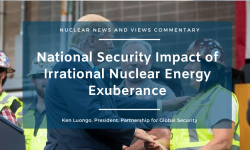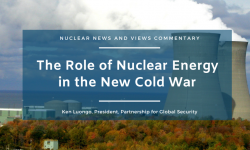Four years ago, the Trump administration issued an analysis of the importance of restoring America’s civil nuclear competitiveness. One of its major recommendations was for the creation of “a whole-of-government approach to supporting the U.S. nuclear energy industry in exporting civil nuclear technology in competition with state-owned enterprises.”
It has largely fallen to the Biden administration to build on this mandate and provide support for the export of U.S. nuclear power reactors.
In the past several years, hundreds of billions of federal dollars have poured into the development and demonstration of next-generation small modular and advanced fuel cycle reactors. At the same time, nuclear power has achieved dramatic new international support as a clean energy technology and response to the need for energy security in an unstable international environment.
These developments have opened the export market to include countries beyond the traditional nuclear-operating states. And winning the nuclear power competition against global rivals will require not just the domestic deployment of nuclear power but the exporting of it. There are several major U.S. government agencies that are instrumental in providing financing and support for this export process and what follows is a review of their activities and target countries.
Export-Import Bank
U.S. EXIM has been providing financing for overseas nuclear projects for more than a half-century. It offers a variety of financing products including direct loans or third-party lender guarantees for overseas technical services, new build, and modernization projects. It also offers four domestic finance programs to support supply chain needs, working capital, and export facilitation.
EXIM has issued Letters of Interest for up to $3 billion for nuclear exports to Poland and Romania. It has a pending nuclear sector transaction for the refurbishment of Romania’s Cernavoda 1 nuclear power plant. It has expressed support for nuclear energy exports to Africa.
Trade and Development Agency
USTDA supports the export of U.S. goods and services for infrastructure projects in emerging economies. Like EXIM, USTDA has committed funding for the export of nuclear power technologies to Poland and Romania. However, it also is supporting activities that could lead to nuclear exports to Ukraine and Indonesia. Much of this funding is for technical activities. It includes a significant focus on the potential export of small modular reactors.
International Development Finance Corporation
DFC is a U.S. government agency that was created out of the Overseas Private Investment Corporation and USAID’s Development Credit Authority. One of the landmark actions of DFC in mid-2020 was reversing OPIC’s legacy prohibition on providing support for nuclear power projects. It is generally looking at civil nuclear projects that can replace dependence on Russian energy. It has provided a $1 billion Letter of Interest for Romanian nuclear projects and it signed a Letter of Intent to support the export of American SMRs to South Africa.
State Department
The Department of State has several nuclear export-related organizations including the Bureau of International Security and Non-Proliferation, and within it, the Office of Nuclear Energy, Safety and Security, that has responsibility for negotiating nuclear cooperation agreements, among other responsibilities.
Beginning in 2021, the State Department created the Foundational Infrastructure for Responsible Use of Small Modular Technology (FIRST) program. It is designed to provide capacity building support to partner nations as they develop nuclear programs. FIRST activities are designed to work in support of the IAEA’s nuclear infrastructure development activities. And Canada, Japan, and South Korea are Contributing Partners.
FIRST has several sub-programs. Last year it launched Project Phoenix which is designed to replace coal plants with nuclear plants in Europe and Eurasia. It also has the Nuclear Expediting the Energy Transition Support (NEXT) and the Winning an Edge through Cooperation in Advanced Nuclear (WECAN) sub-programs. NEXT focuses on providing nations with a “suite of USG-sponsored project preparations tools” including regulatory, financial, and technical advice and training hubs. WECAN is a partnership with Japan on the development of nuclear technologies in third countries, with a first effort in Ghana.
The total funding for FIRST projects seems to be less than $100 million to date, including $25 million for the Nuclear Futures Package. The program identifies over 30 countries that it is working with in South America, Africa, Central Europe, Eurasia, and South Asia. The program notes that it has had over 125 “capacity-building engagements through 2023.” It is not clear how much is being spent on each of the countries that it has engaged.
Commerce Department
The International Trade Administration (ITA) is a key component of the Commerce Department that is dedicated to supporting U.S. companies “in the global marketplace” including in nuclear power exports.
It convenes the Civil Nuclear Trade Advisory Committee (CINTAC) that makes recommendations to the Secretary of Commerce on means of expanding “U.S. exports of civil nuclear goods and services” and “provides for greater U.S. government and U.S. industry coordination on international civil nuclear energy issues…and commercial strategic objectives.”
In addition to CINTAC, ITA has launched the SMR Public-Private Program (SMR PPP) which is designed to promote government-to-government “dialogue and coordination with the private sector.” The focus is on technical assistance to Bulgaria, Romania, and other nations in Europe and Eurasia. It also has created a Small Modular Reactors Working group to support the SMR PPP. ITA is financially supporting Westinghouse’s front-end engineering and design work for the deployment of their reactors in Poland.
Department of Energy
DoE has a vast amount of responsibility for nuclear energy, including its export, safety, security, and civilian and military uses. For FY24, the agency’s proposed budget is over $50 billion.
The two main nuclear organizations most directly responsible for nuclear exports are funded at about $13 million for the newly created office of International Nuclear Cooperation under the Office of Nuclear Energy and $212 million for the office within the semi-autonomous National Nuclear Security Administration that has the main responsibility for nuclear export licensing and nonproliferation.
NNSA is supporting the U.S. Nuclear Nexus, an initiative designed to provide U.S. companies with one-stop access and information on export control laws, regulations, and international safeguards and security requirements. The goal is to ensure that reactor exporters are aware of their national security responsibilities.
It is unclear how much either DoE or NNSA is spending per country to promote and assure the security of nuclear power exports or which countries are the primary targets. The State Department FIRST program’s target list may provide some indication.
Ken Luongo, President, Partnership for Global Security





